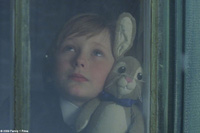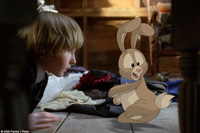I can’t remember how old I was when I first read The Velveteen Rabbit. I was young enough to not quite understand what Scarlet Fever meant or why all the possessions of the child at the center of the story, including his beloved stuffed rabbit, had to be burned. The story didn’t seem dark per se, but it did seem dangerous and mysterious. And even at that young age, I sensed the stuffed rabbit’s quest to be real as serious and important. The story felt grown-up in that way that is irresistible to children. I was hooked.
Indeed, many children (and adults, for that matter) have fallen under the spell of Margery Williams’ tale, first published in 1922. The new adaptation by Michael Landon Jr. and Family 1 Films is the latest of in a long line of people telling this story over and again—on stage, in short films, through animation. Landon gamely suggests his version is only “inspired” by The Velveteen Rabbit. And while this might be an important caveat for purists, given the relatively slight nature of the source material, some imagination is required to fill a feature length presentation.

In Landon’s telling, young Toby is adrift in the world, ignored by his workaholic father and pawned off for a holiday with his begrudging grandmother. He finds the all-important Rabbit in a box in his grandmother’s attic, an unopened and forgotten present from his deceased mother. The attic is a magical place where, as it turns out, generations of Toby’s family have gone to let their imaginations run wild. The magic of the attic is a kind of salve on the pain of feeling unloved.
In the attic, Toby imagines that Rabbit is his best friend, and together they invent a wonderful world, complete with the biggest tree house you’ve ever seen. While he’s in this imaginary world, the movie switches from live action to animation—a storytelling device that is both the strength and the weakness of the production. The animation allows the filmmakers to vividly illustrate what is going on inside Toby’s head and the fantastical nature of the boy’s dreams. The animated portions help us understand the extent to which Toby has developed a parallel world in his imagination, and to appreciate the depth of his bond to Rabbit, with whom he has so many adventures in the attic.

But, let’s face it: Pixar and Disney have spoiled us with amazing animation over the last several years. The animation in The Velveteen Rabbit seems stale by comparison, lacking much of the detail we’ve grown accustomed to. The movie is aimed at a younger demographic, so younger children might be less critical of this aspect of the movie. But older children and parents might find it a touch difficult to get around.
In addition to Rabbit, Toby also meets Horse (voiced by Tom Skerritt) and Swan (Ellen Burstyn), two toys who remember when his father and grandmother used to spend long afternoons in the attic. Horse and Swan regale Rabbit with their own stories of long days in the attic with their own young masters, only to be eventually forgotten about. Horse and Swan are ecstatic to have Toby around because when he’s there, they come back to life and can go on more adventures. Rabbit grows increasingly nervous that he might be forgotten as well. But Horse and Swan suggest there is a way you can avoid this fate—if your owner loves you enough, you can become real, no longer a toy.

While all of this is going on the attic, in the real world Toby’s presence is slowly encouraging his cold grandmother to warm up. He’s staying at her house while his father is working in another city. And it becomes increasingly clear that what Toby wants and needs is his father’s attention. This is never more painfully clear than, when walking down the street with his grandmother, he has the opportunity to throw a stray stickball back to a group of kids playing in a park across the street: He doesn’t know how to throw the ball.
This All-American trope, that a boy needs a father to show him how to play ball, is revisited at the end of the movie when, in his first at bat with his father at his side, Toby hits a home run—capturing the earnest sort of family-friendly fare offered in the film. There is some danger when Toby becomes ill with Scarlet Fever, but little mystery.

During the fever, the action switches back and forth between the imaginary world and the real world. In one, Rabbit, Swan, and Horse grapple with the fact that in order for Toby to be healthy, he can’t live solely with them. And in the other, Toby’s father grapples with the ways in which he’s let his son down by largely ignoring the boy since their wife and mother died. In the end, the characters in both worlds are called on to demonstrate their love in sacrificial ways (which leads to some of the most overtly Christianese lines in the movie, lines that feel forced rather than a natural part of the story).
The book on which this book is based is required reading for … everyone. And while this film version of The Velveteen Rabbit isn’t exactly a classic, it’s a gentle bit of family entertainment that expresses the power of hope in the imaginary world and the importance of communicating our love for one another in the real world.
This film is opening in limited release; click here to see if it’s playing near you. If not, you can still see it soon; it releases to DVD on March 17.
Talk About It
Discussion starters- Why do you think Toby’s father had such a hard time connecting with his son?
- Why do you think God gave us each an imagination? How can it help us live better lives? Can it ever hurt us?
- What do you think about the distinction that it’s not by being loved, but in loving others, that we become real? Why is that an important distinction? Do you think it’s true?
- Have you ever had to make a significant sacrifice for a friend?
The Family Corner
For parents to considerThe Velveteen Rabbit is rated G, and is family-friendly at every turn.
Photos © Copyright Family1 Films
Copyright © 2009 Christianity Today. Click for reprint information.












